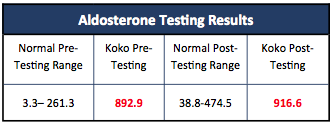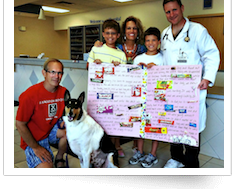Hyperaldosteronism
Written by: Krista E. • 2017 Scholar

History
Koko is a 12-year-old, neutered male Siamese cat. He presented to the rDVM for a 2-3 day history of sneezing, generalized weakness, lethargy, and the inability to lift his head.
Koko was referred to IVS for these concerns as well as severe hypokalemia.
Physical Exam Findings
 Grade 2 heart murmur: This was identified while listening to the heart. It can sound like swishing and is caused by irregular blood flow. They are graded on a scale of 1-6 with grade 1 murmurs being the soft- est and 6 being the loudest. A grade 2 is considered soft, but heard after a few seconds. It was not a major concern in this case.
Grade 2 heart murmur: This was identified while listening to the heart. It can sound like swishing and is caused by irregular blood flow. They are graded on a scale of 1-6 with grade 1 murmurs being the soft- est and 6 being the loudest. A grade 2 is considered soft, but heard after a few seconds. It was not a major concern in this case.
Non-ambulatory and weak: Koko was not willing to move on his own and was physically unable to.
Cervical ventroflexion: This indicates that the head and neck are dropped toward the ground. This is seen in cases of muscular weakness as well as endocrine disorders, such as hyperaldosteronism. Cats lack a nuchal ligament, found in dogs and other animals, which helps keep the neck lifted.
Diagnostic Results
To further investigate why Koko was showing these symptoms, his blood was initially analyzed by the rDVM. This allows the veterinari- an to see how the body is functioning and can provide an explanation as to what is going on internally.
 Significant Results:
Significant Results:
Severe hypokalemia
- The amount of serum potassium was extremely low
- Could be associated with kidney disease
Normal BUN (blood urea nitrogen) and creatinine
- These are nitrogen waste products of blood and are indi- cators of renal health. If the values are high, it is sugges- tive of renal failure. This finding rules out kidney dis- ease.
Elevated aldosterone levels
- Aldosterone is a steroid hormone produced by the cortex of the adrenal glands. It is responsible for con- serving sodium and water and excreting potassium to help stabilize blood pressure by maintaining blood volume levels.
- Sodium and potassium are essential electrolytes to the body. One of their influences is on the ability for muscle movement to occur. In cases of hyperaldosteronism, too much potassium is lost and the action cannot occur resulting in muscle weakness and explains why Koko was unable to lift his neck. Muscle weakness and cervical ventroflexion are classic signs of hypokalemia.
- In addition to low potassium, excessive sodium and water can lead to expansion of the vessels which causes high blood pressure. This was apparent in Koko when his blood pressure was taken and it was extremely high. It was also noted that this pressure caused partial detachment of the retina in each eye, but thankfully, his eyesight was maintained.
Diagnosis
Hyperaldosteronism. This condition is very rare in cats and often underdiagnosed. The elevated aldosterone levels confirmed this diagnosis when testing adrenal gland function. It is commonly associated with a tumor of the adrenal gland(s) which causes over -production of aldosterone and the subsequent symptoms seen in Koko.

Pre-testing = without stimulation. Post-testing = increased expected.
Treatment
Surgery is the preferred method of treatment if a tumor is associated with the adrenal gland(s).
- It is unknown if Koko has an adrenal tumor(s), but obvious kidney disease was ruled out when the
- BUN and creatinine values were normal.
Medical therapy is also a viable option to treat hyperaldosteronism and is the route Koko’s family chose to take. The following medications are most effective and have since been prescribed to Koko:
- RenaKare gel (potassium gluconate): given orally twice daily with food.
- Potassium supplement for treatment of hypokalemia.
- Spironolactone: given orally twice daily.
- Inhibits the action of aldosterone by blocking its receptor, thus holding onto potassium and eliminating sodium and water, reducing blood pressure.
- Amlodipine: given orally once daily.
- An anti-hypertensive drug to combat the high blood pressure. It actually blocks calcium chan- nels which allows the heart to pump easier and widen the blood vessels, keeping the blood pres- sure at bay.
Koko Today
Koko has since been referred back to his regular veterinarian for care. It was recommended that he have his elec- trolyte levels rechecked a couple days after being discharged from IVS and at the discretion of his veterinarian thereafter. A recent update from his family confirmed that he is doing well at home and the treatment is proving effective.
References:
- Bento, D. D., Zahn, F. S., Duarte, L. C., & Machado, L. H. (2016). Feline primary hyperaldosteronism: an emerging endocrine disease. Ciência Rural, 46(4), 686-693. doi:10.1590/0103-8478cr20141327
- Ettinger, S. J., & Feldman, E. C. (2005). Textbook of Veterinary Internal Medicine (6th ed., Vol. 2). Philadelphia, PA: Elsevier Inc.
- Illustration of the cervicothoracic spine, showing spinal nerves and the nuchal ligament. [Digital image]. (2016). Retrieved January 28, 2017, from https://veteriankey.com/surgery-of-the-cervical-spine/
- M. S. (2011). Hyperaldosteronism in Cats. NAVC Clinician's Brief, 59-61. Retrieved June 28, 2017, from http:// www.cliniciansbrief.com/sites/default/files/sites/cliniciansbrief.com/files/Hyperaldosteronism.pdf
- Plumb, D. C. (2005). Plumb's Veterinary Drug Handbook (8th ed.). Wiley-Blackwell.




